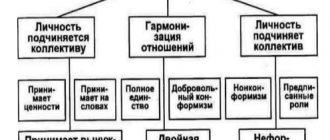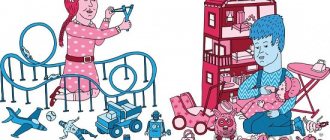Do you know what role each person plays on your team and what you can learn from them? In addition to the formal job role (functions and responsibilities described in the job description), people in the group can also take on a second, team role. Let's figure out what it is and how to use roles to improve the team's work.
Often team roles develop over time, informally, and therefore may go unnoticed. However, a team role summarizes how people tend to behave, how they contribute, and how they will interact with the team over a period of time. For example, one team member may be constantly coming up with new ideas, another may be good at developing contacts outside the team, and another may be great at translating ideas into action. Over time, patterns develop in any team where the same person repeatedly takes on a specific role that others then expect him to perform.
In other words, team roles are an attempt to classify personality types so that the strengths and weaknesses of team members can be identified and recognized
The basis for determining what functions people perform in a group is traditionally considered to be the model of Raymond Meredith Belbin, Doctor of Psychology, Emeritus Professor at the Universities of Bristol and Exter, Advisor to the UN and the European Community Commission on Team Roles or Functions, which he presented in the 80s years of the last century.
In total, Belbin identified nine group roles, or groups of behavior, dividing them into three groups: action-oriented, people-oriented, and thought-oriented. Each team role is associated with typical behavioral and interpersonal qualities. Belbin also identified the characteristic weaknesses inherent in each team role: he called them “acceptable” weaknesses—areas to be aware of and potentially improve.
Action-oriented roles
Shaper
Shapers are people who challenge the team to become better. They are typically dynamic and extroverted individuals who enjoy stimulating others, challenging norms, and finding the best approaches to solving problems. The shaper is the one who shakes up the team and goes through everything inside and out to make sure that all possibilities are fully taken into account. Shapers often view obstacles as exciting challenges and tend to have the courage to overcome them when others are ready to give up.
Their potential weaknesses may be that Shapers are argumentative, impatient, and may hurt people's feelings.
Implementer
Implementers are people who get things done and turn the team's ideas and concepts into practical actions and plans. They are usually conservative, disciplined people who work systematically and efficiently and are very well organized. You can always count on them to get the job done.
The downside is that they can get stuck in their ways and are not always open to new ideas and ways of solving problems: in any case, they would rather stick to old, tried and tested methods than embrace change and innovation.
Pedant
Pedants are people who are task-oriented and ensure that projects are completed completely and that there are no errors or omissions. They pay attention to the smallest details, are concerned with deadlines, and push the team to get the job done on time. Often called perfectionists, they are orderly and conscientious.
However, they are often overly anxious people who have difficulty delegating tasks. All other things being equal, they would rather do something themselves and know that the job will probably be done correctly than entrust it to someone else.
How to identify team roles among employees
Raymond Belbin, in his book Types of Roles in Management Teams, identifies factors that influence the choice of a team role for an individual:
- Personal characteristics;
- Intellectual abilities;
- Internal and external motivation, personal values;
- Past experience;
- Degree of mastery of the team role.
In order to correctly identify a person’s preferred team role, it is recommended to conduct comprehensive testing in three blocks: motivation, intelligence and personality. If you evaluate an employee using just one test, the prediction of his behavior in the team may turn out to be unreliable. Different factors are important for different roles.
For example, to identify an Idea Generator, you need to assess a person’s personality, intelligence and motivation. While to determine the Implementer, it is enough to evaluate only motivation and personality.
However, with the help of testing it is impossible to find out about the employee’s past experience and his degree of mastery of the team role. To solve this problem, a hybrid assessment technology is used, where testing is combined with an interview with an expert. The test evaluates motivation, intelligence and personality, and the expert, in a personal conversation, finds out the employee’s past experience, the team role that the person chose at the previous place of work and the reasons for this choice.
As a result of a comprehensive assessment, a complete picture is formed about the employee - his potential, abilities and personal characteristics.
Note that one person can combine several team roles: one manifests itself more, the other less. For example, an employee can be both an Analyst and the Soul of the team, or a Motivator and Implementer. That is, the team does not have to consist of nine members, where each employee plays one specific role. The main thing is that team members clearly understand their roles and complement each other.
People-oriented roles
Coordinator
Coordinators are those who take on the traditional role of team leader and are also called chairs. They guide the team toward what they perceive to be goals, are often excellent listeners, and are keenly aware of the value that each team member has. They are calm, good-natured and distribute tasks effectively.
A potential weakness of coordinators is that they may delegate too many tasks that are personal responsibility and tend to be manipulative.
Soul of the team
The soul of a team is the people who provide support and make sure everyone on the team works together effectively. They serve as negotiators, usually flexible, diplomatic and insightful people, usually popular, who are very capable in their own right, but prioritize team cohesion and helping others.
However, they may be indecisive when making group decisions because they are torn between the well-being of individual team members and the team's ability to function as a cohesive unit.
Resource Explorer
Resource Explorers are resourceful and curious, exploring all available options, making contacts, and negotiating resources on behalf of the team. They are enthusiastic team members who identify and work with external stakeholders to help the team achieve its goals. They are outgoing and often extroverted, which makes others often very receptive to them and their ideas.
On the other hand, such people can just as quickly lose enthusiasm and are often overly optimistic.
Role theory in psychology
For the first time, the concept of a social role as the primary structural unit of society was proposed by American sociologists J. Mead and R. Linton in the 30s of the 20th century. Later, this idea was repeatedly addressed by representatives of social psychology, and by the end of the last century it took shape in a fairly coherent theory that explains the processes of interaction between man and society.
Role as a function of a person in society
Lions live in prides, wolves live in packs, and people live in social groups. These are communities of individuals united by a common goal and joint activities aimed at achieving it. Any group activity requires the distribution of functions that presuppose a certain type of behavior, a set of responsibilities, a person’s position in society, etc.
These functions, from the point of view of psychology, are the social roles that people play, and society makes strict demands on role behavior, since the achievement of a common goal depends on it. In each group there are many such roles, their content is determined by the tasks of group-wide activities. So, in a school team there are the roles of students, teachers, director, head teacher, technician, librarian, etc. Since a person usually belongs to different groups in which he performs different functions, he also plays more than one role. It's not just about formal groups. The same roles exist in the family: husband, wife, son, daughter, mother, father, etc.
When accepting a new role, a person must first of all understand its functional component, that is, understand what contribution he should make to the overall activity, what the community expects from him. Without this, it is impossible to master the role. And if in official groups the functions of each member are described in the relevant documents as job responsibilities, then in a family this is not the case. Therefore, an incorrect understanding of the functional component of one's role or an unwillingness to understand it leads to inevitable conflicts.
Failure by a person to fulfill his role functions not only causes a negative reaction from the group; social sanctions can be applied to the person: from open condemnation to expulsion from society.
Role as a behavioral stereotype
The role has a complex structure and includes the following components:
- social norms;
- responsibilities associated with performing group functions;
- human rights as a member of a given group;
- role behavior stereotypes.
Stereotypes of behavior ensure the effectiveness of a person’s performance of his role functions, therefore they are given great importance in role theory. They include the most rational and generally accepted methods and forms of activity and norms of relations with other members of the group. In addition, behavioral stereotypes make the role recognizable and help a person quickly navigate the social environment. Since childhood, we know what actions should be expected from a doctor, salesman, hairdresser, teacher, etc. And taking a new role, it is easier for a person to master stereotypes of behavior, since he knows in advance how to behave in a given situation.
The two sides of the social role - functional and behavioral - can be represented as follows:
- role, as a function, prescribes what a person needs to do;
- a role as a set of behavioral stereotypes - how it should be done.
Social roles are not only standardized, but also impersonal. Of course, each person is a unique person, and his individuality leaves an imprint on his role behavior, but this should not go beyond stereotypes. Any social role includes a strictly defined system of responsibilities, and no matter who plays this role, the set of requirements does not change. So, the seller can offer us a product with jokes and jokes, but he must at the same time fulfill his functions. And if, instead of selling, he teaches us how to dress or raise children, then at least they will not understand him.
The situation is somewhat more complicated with stereotypes of role behavior in a group such as a family. Although there are standards of behavior for a husband, wife, children, grandmother, grandfather, father, mother, etc., they are more vague, as they are based on informal traditions and customs, ideological principles and values. Role behavior in the family is influenced by both religious beliefs and emotional relationships. The child learns patterns of such behavior from the example of his family, and in some details (and sometimes significantly) they may differ from what is customary in other families.
This may cause difficulties in the future when the grown children decide to start their own families. Thus, a young man raised in a family where all household responsibilities are assigned exclusively to the woman will expect the same behavior from his chosen one. And, for example, a girl’s request to wash the dishes or vacuum the floor can cause him bewilderment and even offense.
When communicating with people, we unconsciously expect a certain role behavior from them, just as they expect from us. These expectations, based on ideas formed during the process of socialization, are called expectations in social psychology. If expectations do not coincide due to differences in culture, beliefs or family upbringing, then conflict may arise. The discrepancy between mutual expectations is one of the most common reasons for the breakup of young families.
Thought-oriented roles
Idea's generator
An Idea Generator is a creative innovator who comes up with new ideas and approaches. They love praise, but have a particularly difficult time dealing with criticism. Such people are often reserved and prefer to work separately from the team. Since their ideas are innovative, sometimes they may not be practical.
Idea generators tend to ignore given parameters and limitations; they are often introverts who may have poorly developed communication skills.
Analyst-strategist
Strategic analysts are best at analyzing and evaluating ideas that others (often idea generators) come up with. These people are insightful, objective, and carefully weigh the pros and cons of each option before making a decision.
Because they think critically and are very strategic, they are often perceived as aloof or unemotional.
Specialist
Specialists are people who have the specialized knowledge needed to perform a job. They take pride in their skills and abilities and work to maintain their professional status. Their main concern as a team is to be experts in their field, they are fully committed to their knowledge. Specialists, as a rule, are purposeful and professional.
Which, in turn, may limit their contribution. Also, given the focus on practical aspects, the specialist may have trouble actually applying his experience to solve the broader problems of the team.
What is the Belbin Team Role Model?
Raymond Meredith Belbin, PhD, director of Belbin Associates Ltd, created a theoretical model of team roles in the 1960s and 1970s. It consists of 9 types and is divided into 3 groups: intellectual roles - Idea Generator, Strategic Analyst, Specialist; social roles - Soul of the team, Resource Explorer, Coordinator; action roles - Motivator, Implementer, Pedant.
The main idea of the model: a work team is most effective when it consists of people with different abilities, ways of thinking and personal qualities. At the same time, it is important that team members not only differ, but complement each other. Then the process will work according to the principle of a conveyor belt, where each employee performs his specific functions in the project, and then passes it on further along the chain.
When a business process is established in a team, none of the employees waste time, do double work or compete with each other. Each participant understands his role and does exactly what the manager and his team expect of him.
Let's take a closer look at each team role, functions, pros and cons.
Reference groups
It is the group to which a person or another group is compared. Reference groups are used to study and determine personality or other characteristics and sociological characteristics of other groups.
This is the group to which a person belongs or seeks to psychologically associate himself. This becomes the individual's guide and source for drawing on his or her experiences, perceptions, needs and self-images.
These groups act as a standard and contrast necessary for comparing and assessing group and personal characteristics.
What to remember
- If several people in a work team duplicate each other in roles and functions, ineffective distribution of resources within the group occurs and overall performance decreases. Belbin's theory of team roles is designed to address this problem;
- Belbin's model consists of 9 types and is divided into 3 groups: intellectual roles - Idea Generator, Strategic Analyst, Specialist; social roles - Soul of the team, Resource Explorer, Coordinator; action roles - Motivator, Implementer, Pedant;
- In order to identify team roles among employees, it is recommended to use a personnel test assessment. Different factors are important for different roles, so the assessment should be comprehensive and consider a person in three areas: motivation, intelligence, personality;
- After the assessment, you can form a team. Start with the most important role for the project, and then select the remaining participants so that they complement each other's qualities and neutralize each other's shortcomings. The balance of power of the entire team is important here;
- Belbin's team role model will help form an organic work team that will be able to effectively cope with assigned tasks and regularly bring benefits to the company.
Recommended reading
- E.E. Lynchevsky “Psychological climate of a tourist group”, M., “FiS”, 1981, this lecture is based on this book.
- "Mountaineering School" ???
- Selected publications in Tourist magazines.
- As well as a variety of literature on psychology, mainly social:
- Samygin S.I., Stolyarenko L.D. “Psychology of Management”, M., “ZEUS”, 1997
- M. E. Litvak “Command or obey”, Rostov-on-Don, “Phoenix”, 1997
- E.V. Rudensky “Social psychology”, M.-N., 1998
“Formation of positive group motivation”
The test can be used both for individual work and for collective assessment of factors related to the formation of group-wide motivation.
Instructions: Here is a test containing 25 factors (positive and negative).
These factors make it possible to assess the degree of formation of group motivation. We ask you to carefully evaluate these factors and select the appropriate score. Circle the number that corresponds to your ideas.
| Predominant factors | Points | Predominant factors |
| 1. High level of group cohesion | 7 6 5 4 3 2 1 | Low level of group cohesion |
| 2. High activity of group members | 7 6 5 4 3 2 1 | Low activity of group members |
| 3. Normal interpersonal relationships in the group | 7 6 5 4 3 2 1 | Poor interpersonal relationships in the group |
| 4. Absence of conflict relations in the group | 7 6 5 4 3 2 1 | Presence of conflicts in the group |
| 5. High level of group compatibility | 7 6 5 4 3 2 1 | Low level of group compatibility |
| 6. Personal understanding of organizational goals and their acceptance | 7 6 5 4 3 2 1 | Employees' failure to accept organizational goals |
| 7. Recognition of the authority of the leader | 7 6 5 4 3 2 1 | Group members do not recognize the authority of the leader |
| 8. Respect for the manager’s competence | 7 6 5 4 3 2 1 | Group members do not give due credit to the leader's competence |
| 9. Recognition of the leadership qualities of a manager | 7 6 5 4 3 2 1 | Group members do not consider their leader to be a leader |
| 10. The presence of a trusting relationship between group members and the leader | 7 6 5 4 3 2 1 | Lack of trust between group members and the leader |
| 11. Participation in collective decision-making by group members | 7 6 5 4 3 2 1 | Lack of participation of group members in decision making |
| 12. There are conditions for expressing the creative potential of employees | 7 6 5 4 3 2 1 | There are no conditions for expressing the creative potential of group members |
| 13. The desire to accept responsibility by group members for the work performed | 7 6 5 4 3 2 1 | Lack of desire among group members to accept responsibility for the work performed |
| 14. Good psychological climate in the group | 7 6 5 4 3 2 1 | Poor psychological climate in the group |
| 15. High level of control over the actions of each group member | 7 6 5 4 3 2 1 | Low level of control over the actions of each group member |
| 16. Having an active life position within the group | 7 6 5 4 3 2 1 | Lack of an active life position within the group |
| 17. The desire for self-realization among group members | 7 6 5 4 3 2 1 | Lack of desire for self-realization among group members |
| 18. High degree of coordination of actions among group members | 7 6 5 4 3 2 1 | Weak degree of coordination of actions among group members |
| 19. Formation of group-wide values | 7 6 5 4 3 2 1 | Lack of group-wide values |
| 20. No stress within the group | 7 6 5 4 3 2 1 | Presence of stress within the group |
| 21. Desire to work in a group | 7 6 5 4 3 2 1 | The desire of group members to work individually |
| 22. A manager’s positive attitude towards his subordinates | 7 6 5 4 3 2 1 | Negative attitude of the leader towards group members |
| 23. Positive attitude of group members towards their leader | 7 6 5 4 3 2 1 | Negative attitudes of group members towards their leader |
| 24. Acceptance of moral standards of behavior within the group | 7 6 5 4 3 2 1 | Lack of moral standards of behavior within the group |
| 25. The ability to show independence in solving assigned tasks by group members | 7 6 5 4 3 2 1 | Lack of desire among group members to independently solve assigned tasks |
Social role and social status
Social status is a person’s position in society, which corresponds to his age, gender, profession, origin and marital status.
To achieve a certain status, a person must adhere to one or another type of behavior, conform to the role, that is, perform specific actions.
For example, the coach of a basketball team is an authoritative status in a sports society. To lead the team to victory, he needs to train and train athletes. Thus, the social role represents a full range of actions to achieve social position and maintain it in the future.
We conclude: social status is a position, and a role is a pattern of behavior that is associated with status.
| Types of social statuses | |
| Name | How to purchase |
| Group status | In large groups: representatives of a profession, religion, nation. |
| Personal status | In small social groups: family, work collective. |
| Basic status | For a long time and determines the social position of a person in society. |
| Episodic status | For a short time and in a certain situation: transport passengers, pedestrians, etc. |
| Prescribed status | After any events: son-in-law, daughter-in-law, etc. |
| Achieved (acquired) status | As a result of a person’s personal aspirations and work: master of sports, Olympic medalist, etc. |
Social role theory
The American sociologist Merton was the first to draw attention to the fact that any social status has a whole set of social roles. This discovery formed the basis of his theory.
Currently, in science, such a set is called a role set . It is assumed that the richer it is, the better for the realization of the person himself. If a person has a small number of roles, then in this case we can talk about severe isolation from society.









